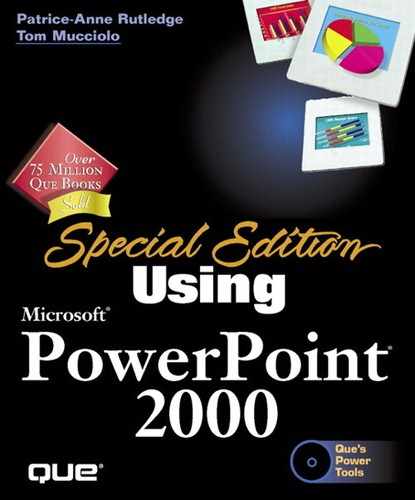Setting Slide Transitions
Setting slide transitions is one of the most common PowerPoint animation effects. You can set slide transitions that apply to the entire presentation or just to the current slide. Transition options include:
Blinds
Box
Checkerboard
Cover
Cut
Dissolve
Fade
Random bars
Split
Strips
Uncover
Wipe
Within each of these main categories, you have other directional choices. For example, you can wipe up, down, left, or right.
Caution
It's best to use a limited number of slide transition effects for your entire slide show unless you have a good reason for applying many different transitions. Too many transitions can make your presentation confusing.
Tip
If you're not sure which transition effect to use or what each looks like, go to Slide Sorter view where you can attach slide transitions and preview them all in the same window.
→ To understand more about using transitions in this view, see "Setting Transitions in Slide Sorter View."
Setting Transitions in the Slide Transition Dialog Box
To set slide transitions, follow these steps:
Choose Slide Show, Slide Transition. Figure 14.1 shows the Slide Transition dialog box.
From the drop-down list in the Effect group box, select the transition you want to apply.
Choose a transition speed of Slow, Medium, or Fast, depending on how quickly you want the transition to occur in a slide show.
Select the On Mouse Click check box to advance to the next slide when you click the mouse or press a key such as the spacebar, Enter, Page Up, or Page Down keys. This is selected by default.
If you would rather have PowerPoint automatically transition to the next slide after a specified amount of time, select the Automatically After check box, and then enter a specific time in the field below.
To add sound effects to your transition, select a Sound from the drop-down list.
 Can't hear your sound files?
See the Troubleshooting section at the end of the chapter.
Can't hear your sound files?
See the Troubleshooting section at the end of the chapter.Tip
To add a sound other than one of the default WAV files, select Other Sound from the drop-down list. This opens the Add Sound dialog box, from which you can choose another sound.
→ To learn how to add WAV and other sound files, see "Inserting Your Own Sound File."
Note
Use the Loop Until Next Sound check box to continually play a selected sound until the presentation encounters another sound file.
Click the Apply to All button to apply these transition effects to your entire presen-tation.
Click the Apply button to apply these transition effects only to the current slide.
To preview what the animation will look like in a slide show, choose Slide Show, Animation Preview. A preview window displays the actual animation effect, shown in Figure 14.2.
Figure 14.2. Preview your animation to make sure it has the desired effect.

Setting Transitions in Slide Sorter View
You can also set slide transitions in Slide Sorter view, which enables you to view all your slides at the same time. Figure 14.3 illustrates this view.
→ For more details on this view, see "Using the Slide Sorter View."
Click the Slide Sorter View button in the lower-left corner of the PowerPoint window to open the presentation in Slide Sorter view. Select the slide or slides to which you want to set the transition, and then choose the transition from the Slide Transition Effects drop-down list on the Slide Sorter toolbar. These transitions are identical to the ones you can apply from the Slide Transition dialog box.
Figure 14.3. Setting slide transitions in Slide Sorter View is another option.

Tip
To select non-contiguous slides, press the Ctrl key and click the slides you want.
Tip
The best way to get a real-time view of your slide transitions is to view your actual slide show. To do this, click the Slide Show button in the lower-left corner of the screen to open your show starting with the current slide. To open the show at the beginning, choose Slide Show, View Show from the Standard menu or press F5.
→ To get more information about previews, see "Previewing Your Show."

